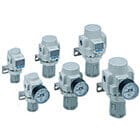3 Types of Pneumatic Valves and Their Applications
Directional control pneumatic valves are a necessity in your machine. With their applications, various control valves regulate the rate and amount of air that can flow through the machine, which in turn determines output. If a valve isn’t working, then air pressure won’t be consistent and the actuator will fail to generate power.
5 Key Components of Pneumatic Systems
Pneumatics is a system that involves using air pressure as a source of energy. The benefits include using natural atmospheric air — which is free to use as a compressed gas and is not combustible. That means that the pneumatics machine will not cause explosions in the workplace, and thus increases safety for the operators and employees nearby.
Basic Pneumatics: Complete Guide
Pneumatics is the process of using compressed air to create pressure. Due to the nature of how gases work, decreasing the volume of a gas will increase its pressure and that in turn will generate a force. You can reduce gas volume by enclosing the molecules in a small space and forcing them closer together. The whole process runs on air-related physics.
The Importance of Pneumatic Regulators
All pneumatic machines utilize compressed air pressure to run. The molecules come together when air volume is reduced, which generates a veritable force. Per Boyle’s Law, lowering volume increases the air pressure within a designated area as long as the temperature and mass are consistent. Molecules hit the compressor and circuit Then the machine circulates this pressure to the cylinders or motors until the work is done.
3 Gases Used in Pneumatic Systems
Pneumatic systems are a cost-effective means of manufacturing the items that you sell and keeping quality control consistent in the food and medical industry. Operators appreciate the low learning curve and relatively easy maintenance. You have to replace parts on pneumatics air machines less often than you need to for hydraulic machines, and the parts overall cost less.




